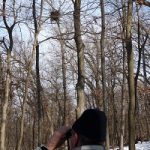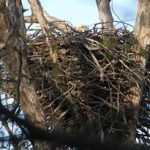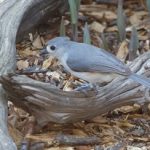Pileated Woodpecker on Suet
The pileated woodpecker checked out the suet and finally flew to the ground then up to the feeder to hammer out chucks of suet. Then, off to the tree where a female played hide and seek with it.
The pileated woodpecker checked out the suet and finally flew to the ground then up to the feeder to hammer out chucks of suet. Then, off to the tree where a female played hide and seek with it.
Well, the turkey characters are at it, again! Up they come each morning even before sun up, looking quite fit and hale, and gobbling for breakfast. At Winding Pathways we get a kick out of the web pages and sporting flyers that detail all the equipment one needs to bag a turkey and how early one has to get up to beat the turkeys out of bed. Special camo clothes, calls, camo guns, shells. To the credit of the web sites, they do offer intriguing information on strutting, clutches of eggs, turkey senses, and habitat. A Kidzone site shares an interesting story of the “mix-up” of the name. and, of course, Audubon gives a great set of pictures and details about turkeys. All fun reading.
From the comfort of our home, we sip our coffee and watch a crew of seven meander up from the ridge where they roosted and another eight that saunter over from the neighbor’s trees. Then, it is the Sharks and the Jets (think West Side Story) as they squabble over the seed tossed out – not for them – but for the song birds. Or look at us with pathetic longing, trying to make us think they are starving. Ha!
Meanwhile, the less dominant males slide in for a feast.
Same with mating. The dominant males strut and intimidate and the less aggressive males sidle up to a female that is ready and mate. Maybe we will eventually have less pushy turkeys.
Enjoy this gallery of winter and spring turkey antics.
We’re lucky to have a pair of bald eagles nesting within walking distance of our home. Occasionally we clamber through the woods to check on the couple, but we’re careful to not disturb them. We stay a hundred yards away from their nest tree and spy on them through binoculars.
On March 12 Rich witnessed a remarkable trait of eagle parentage. Incubation is a female task with most birds. The male rarely sits. Not so with bald eagles. The soon-to-be father helps keep the eggs warm. Rich happened to be near the nest during the changing of the guard.

Watching from a distance.
He could see just the white crown of the sitting eagle’s head protruding from the huge nest built high in a white oak tree. Its mate perched on a limb about 50 yards away. Suddenly the sitting bird climbed off the eggs, spread its wings, and began circling the nest. Its mate joined the circling. After a few revolutions around the nest the recently sitting bird made a beeline north, presumably to look for dinner. The remaining eagle circled a few more times before settling down on a branch near the nest. After a minute or two it hopped into the nest and settled down over the eggs.
Who was who? Male and female bald eagles look alike, so Rich couldn’t tell if the male or female was the first incubator. It doesn’t really matter. Cooperation between the two is fascinating as this link shows.
Eagle parentage is an exercise in teamwork. The pair built the nest, take turns incubating, and both hunt for nestling food.

Eagles share parenting duties. Photo by M. Norlander
Eagle nests are becoming more common everywhere. The birds mostly feed on fish, so likely nest locations are near rivers, lakes, or the ocean. Nests are enormous piles of sticks, usually high in a tree and easy to spot. Bald eagles don’t seem bothered by roads, stores, or houses and often nests are within sight of heavy human activity.
Find a nest, dress warmly and sit some distance away with a pair of binoculars. You’ll be treated to examples of outstanding parentage. We plan to spy on our local eagle pair from a distance through the 35-day incubation period and as they raise their chicks.
Nearly everyone who feeds birds across the eastern United States enjoys luring

The tufted titmouse is a year round resident in much of the Eastern United States. It’s late winter call is a sure sign of spring.
the black capped chickadee, white breasted nuthatch, downy woodpecker, goldfinch, and cardinal to the yard. All are fascinating nonmigrating birds of deciduous forests and suburbia. We love all these birds but especially enjoy the tufted titmouse.
The titmouse also loves living in suburban areas and wooded places. It’s a homebody that doesn’t migrate, so they can be seen all year. However,titmice are most commonly spotted when visiting feeders for meals of sunflower seeds.
The titmouse has a more limited range than chickadees or nuthatches. At Winding Pathways in Eastern Iowa we are near the northern and western edge of their range. From Iowa they range east to the Atlantic Ocean and south from New England to the Gulf of Mexico.
A titmouse has a surprisingly loud voice for such a small bird. We enjoy hearing them as we walk in our yard. To learn more about this beautiful bird, and to enjoy its song go to the Cornell University Laboratory of Ornithology’s website.
A recent article in LIVING BIRD Magazine reported that cats kill more than 2.4 billion birds each year in the United States. Their numbers came from the book, CAT WARS, by Peter Marra and Chris Santella.
use cats are fascinating animals that are loved by 600 million people worldwide who keep one or more as pets. They’ve been part of the human experience since at least the dawn of agriculture. Descended from a species that remains wild in Saudi Arabia, Israel, and other Middle Eastern countries, cats were informally domesticated as early as 10,000 years ago. Probably the earliest semi tame cats were wild individuals who lived near cultivated fields and hunted mice and other pests. At some point people began taking them into their homes as pets.
House cats followed humans as they spread around the globe and today are common wherever people live. Unlike many domestic animals that long ago lost their ability to survive in the wild, cats often go wild. These “feral” animals have a high reproductive rate and can create a large wild population in a relatively short time. Often these colonies of feral cats prey on animals that have no defense against them.
Cats never lost their ability to hunt and continue to catch animals, especially mice and other small mammals. Unfortunately they are also effective bird predators. Cats kill more birds than collisions with buildings, power lines, and wind turbines combined. They pose a serious threat to some bird populations.
There is a simple way that cat lovers can enjoy their pet while reducing the impact of these fascinating animals on birds…….keep them indoors.
For more information:
Cat Wars: The Devastating Consequences of a Cuddly Killer. Princeton University Press.
The Cornell University Laboratory of Ornithology.
*Note: Winding Pathways is not paid by companies we feature.
Cold weather in the northern hemisphere and the Holiday Season everywhere are upon us and many gifts for bird lovers fill store shelves. But, shopping for seeds to fill the backyard feeder can be confusing and even frustrating. Many types of seed and mixes are for sale. Some blends are designed to attract specific species, like cardinals, while others target a diversity of birds. Cheap blends appeal mostly to house sparrows and blackbirds, species most people prefer to not attract.
Winding Pathways suggests keeping seed buying simple. We have a favorite seed, one we avoid, and one that we use in a special way. We rarely buy cheap mixes that song birds really do not like and that are sold in big box, chain and grocery stores at inflated prices. Farm stores often sell better mixes at lower cost. Neither of these types of stores have knowledgeable staff to help new comers to winter bird feeding. Specialty bird feeding stores offer the highest quality seed and staff up-to-date in what song birds feed on. And, yes, you pay a bit more – and we find it worth the cost. Less wasted seed and higher satisfaction for homeowners and the birds!
THE BEST SEED FOR WILD BIRDS
Of the many outstanding seeds for feeding birds we like black oil sunflower the best. It’s relatively inexpensive and devoured by chickadees, titmice, nuthatches, woodpeckers, cardinals, and many other species. We don’t mind that birds drop hulls to the ground but for people who dislike this mess, hulled sunflower seed can be purchased and is excellent. It is kernels of larger culinary sunflower seeds, sometimes called gray stripe seed. Hulls have been removed and seed is much more expensive but loved by birds. Most sunflower seeds are produced on farms in the Dakotas and Minnesota.
THE WORST SEED
The worst seed is Milo. It is a common ingredient in cheap mixes and sometimes is sold as “bird seed.” Milo is grown on arid land in the Great Plains and is mainly used for livestock feed. The young plant looks like corn but unlike corn its seeds form at the top of the plant. Few birds like the astringent seeds, although they will sometimes eat it if nothing else is available and they are hungry. Less desirable species, like house sparrows and blackbirds will eat it. Milo seeds are round, slightly reddish, and about twice the size of somewhat similar millet. Try to avoid it.
IN BETWEEN SEEDS
An excellent inexpensive seed that will be eaten by many birds is cracked corn. Desirable birds prefer sunflower seeds, but we often sprinkle some cracked corn on the ground to keep sparrows and wild turkeys happy and, hopefully, away from our sunflower seed. Another seed of “in between” value is millet. These are tiny round white or yellowish seeds often found in inexpensive mixes. Mourning doves, juncos and other ground feeders enjoy eating it. So do house sparrows.
Learning to identify seeds helps a customer purchase the best seed at the lowest cost. Reading labels helps as most manufacturers list the contents of their seed packages. Happy Holidays to you and the birds you love to feed!